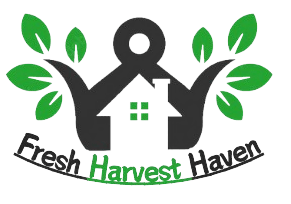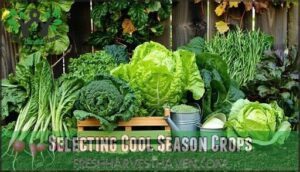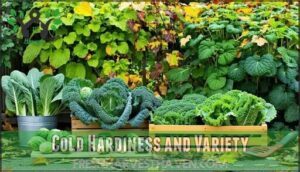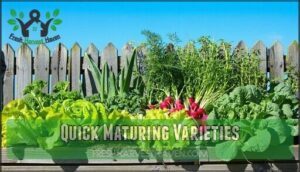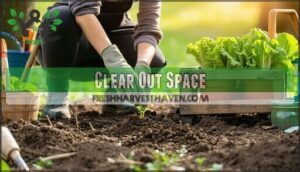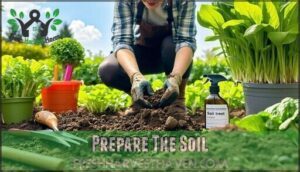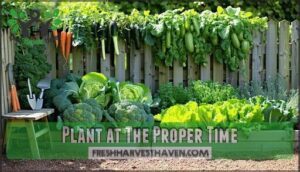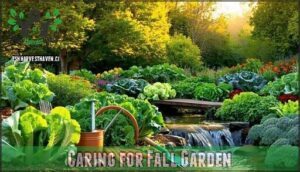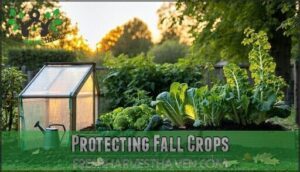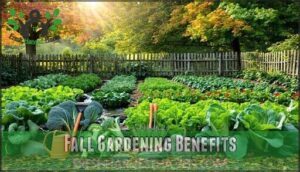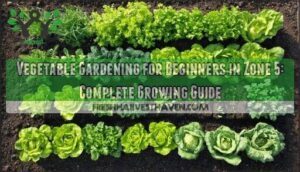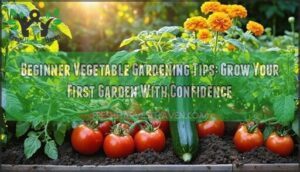This site is supported by our readers. We may earn a commission, at no cost to you, if you purchase through links.

While summer’s heat wilts your neighbors’ gardens, you’ll be growing crisp lettuce, sweet carrots, and hardy kale that actually prefer cooler weather.
Start by counting backward from your first frost date—usually 8-12 weeks—to time your plantings perfectly.
Cool-season crops like spinach, radishes, and broccoli mature faster in autumn’s mild temperatures, need less water, and face fewer pests than their summer counterparts.
The secret lies in soil preparation and choosing quick-maturing varieties designed for shorter days, which is a key factor in successful fall gardening, allowing you to master these timing tricks and discover which protective methods work best in your climate, making you wonder why anyone stops gardening when the real growing season begins.
Table Of Contents
- Key Takeaways
- Fall Gardening Basics
- Choosing Fall Plants
- Planting Fall Garden
- Caring for Fall Garden
- Protecting Fall Crops
- Fall Gardening Benefits
- Frequently Asked Questions (FAQs)
- What are fall gardening lessons?
- Is fall gardening good for beginners?
- Why is fall a good time to start a garden?
- How do I start fall gardening?
- What can I plant in the fall?
- Is fall a good time to plant a garden?
- What is the easiest plant to grow in the fall?
- What should you not plant in the fall?
- When should you start a fall garden?
- What gardening should be done in the fall?
- Conclusion
Key Takeaways
- Time your plantings by counting backward from your first frost date – Add 8-12 weeks plus extra time for slower fall growth to ensure crops mature before winter hits.
- Choose cool-season crops that thrive in cooler temperatures – Plant lettuce, spinach, kale, radishes, and broccoli since they actually prefer fall weather and taste sweeter after light frosts.
- Prepare your soil with compost and organic matter – Fall’s cooler conditions make soil prep easier while giving you a nutrient-rich growing medium for better root development.
- Use protective methods like row covers and cold frames – These simple tools extend your growing season by 4-6°F and protect crops from pests while giving you fresh vegetables well into winter.
Fall Gardening Basics
Fall gardening opens up a whole new growing season that many beginners overlook, giving you fresh vegetables well into winter.
You’ll discover that cooler temperatures actually make gardening easier, with fewer pests to battle and plants that handle stress better than their summer counterparts, making it a great time for fresh vegetables.
Fall’s cooler weather means fewer bugs and less plant stress—your garden practically takes care of itself.
Autumn Garden Overview
Throughout autumn’s changing landscape, fall gardening offers beginners a rewarding entry point into seasonal cultivation.
Your autumn gardening guide starts with understanding garden layout and fall planning essentials.
Cool temperatures create ideal conditions for seasonal blooms and leafy greens, while proper crop rotation maintains soil health.
This gentler growing season lets you master fundamental techniques without summer’s intense heat stress, making beginner gardening surprisingly achievable and enjoyable.
By incorporating fall gardening tips into your routine, you can create a thriving autumn garden.
Importance of Fall Maintenance
Now that you understand what fall gardening offers, proper garden maintenance becomes your foundation for success.
Think of autumn care like preparing your home for guests – everything needs to be clean and ready.
Soil preparation starts with adding compost to refresh nutrient-depleted beds.
Your summer crops have been hungry guests, taking what they need before leaving.
Tool maintenance means cleaning and storing equipment properly to prevent rust over winter.
Here’s your fall garden preparation checklist:
- Remove spent plants and weeds that harbor pests
- Fall pruning of dead branches improves air circulation
- Shred fallen leaves for nutrient-rich mulch
- Apply compost to beds for spring soil improvement
- Clean and oil tools before storage
This garden cleanup sets you up for easier spring planting while protecting your investment in quality tools.
Preparing for Winter
Winter preparation transforms your fall garden into next season’s success story. After completing your fall garden maintenance, you’ll want to focus on garden winterization tasks that protect your investment.
Start with winter soil prep by applying compost and organic matter before the ground freezes. This feeds beneficial microbes and improves spring texture. Mulch application around plants provides frost protection for tender roots – think of it as a cozy blanket for your garden.
Mulch Application
Consider cold frame gardening for season extension and winter crop selection. These simple structures create microclimates that keep lettuce and spinach growing through winter. Clean and store tools properly – rusty equipment makes spring gardening frustrating. Your autumn garden preparation sets the foundation for next year’s bounty.
Choosing Fall Plants
Selecting the right plants for your fall garden sets you up for a successful harvest before winter arrives.
You’ll want to focus on cool-season crops that actually prefer cooler temperatures and can handle light frosts better than your summer favorites.
Selecting Cool Season Crops
The best cool-season crops for autumn planting include leafy greens, root vegetables, and cruciferous plants that actually prefer cooler temperatures.
Fall vegetables like lettuce, spinach, and radishes mature quickly in thirty to forty-five days, while broccoli and kale need more time.
Smart garden planning means choosing seed choices that match your first frost date and growing zone for successful fall harvest results.
Understanding fall crop timing is vital for a bountiful harvest and requires careful consideration of factors like temperature and moisture levels.
Cold Hardiness and Variety
Cold hardy varieties are your secret weapon against winter’s bite.
Kale and spinach actually improve after frost, developing sweeter flavors that’ll make you forget summer tomatoes.
Brussels sprouts need those chilly nights to reach peak taste.
Choose coldhardy varieties matched to your zone—leeks laugh at freezing temperatures while frost protection keeps tender crops thriving longer.
Understanding cold hardiness levels is essential for selecting the right crops for your region.
Quick Maturing Varieties
Speed matters when autumn days grow shorter.
Quick maturing varieties let you harvest fresh Cool Crops before winter arrives, making fall gardening for beginners both rewarding and achievable.
These Fast Greens and coolseason crops thrive in cooler temperatures while delivering quick results:
- Radish Varieties – Ready in just 24-30 days, perfect for beginnerfriendly vegetables
- Fall Lettuce – Harvest crisp leaves in 30-45 days with continuous cutting
- Quick Peas – Sweet snap peas mature in 50-60 days before hard frost
- Spinach – Dense, nutritious leaves ready in 30-40 days for fall vegetable varieties
These fall vegetable varieties give you the best chance of success before winter weather arrives.
Planting Fall Garden
Once you’ve selected your cool-season crops, it’s time to get them in the ground before fall’s window closes.
The key is clearing summer remnants, enriching your soil, and timing your planting just right for your area’s frost schedule.
Clear Out Space
Transform your garden into a fall paradise by tackling garden cleanup with purpose. Remove spent summer plants and debris disposal becomes your first priority.
| Task | Why It Matters |
|---|---|
| Pull weeds | Prevents competition for nutrients |
| Clear diseased plants | Stops disease spread next season |
| Compost healthy material | Creates nutrient-rich soil amendment |
| Remove plant debris | Eliminates pest hiding spots |
| Plan new layout | Maximizes space for cool crops |
This space planning sets your autumn garden preparation up for success, creating room for those delicious cool-season vegetables you’ll soon plant. Effective fall garden cleanup involves understanding soil preparation techniques to improve your garden’s overall health.
Prepare The Soil
How can you turn tired soil into a thriving foundation for your fall crops? Start with soil testing to identify pH levels and nutrient gaps.
Compost addition transforms depleted earth into rich growing medium. This process is crucial for a successful harvest.
- Test soil pH and adjust to 6.0-7.0 range for ideal nutrient uptake
- Mix 2-3 inches of compost into garden beds for improved structure
- Apply organic fertilizer based on soil test recommendations
- Loosen compacted soil 8-12 inches deep for healthy root development
- Add mulch application after amendments to retain moisture and warmth
This soil preparation guarantees your composting tips and garden preparation efforts pay off with robust fall harvests.
Plant at The Proper Time
Success isn’t just about what you plant—it’s when you plant it. Frost dates serve as your gardening GPS, helping you navigate planting calendar decisions with confidence. Seasonal gardening requires precision timing for maximum results.
Understanding a gardening calendar is vital for planning.
Here’s your three-step timing strategy:
- Calculate backwards from your first frost date using seed packet maturity days
- Add two weeks for the "fall factor" since cooler temps slow growth
- Stagger plantings every 10-14 days for continuous harvest timing
This approach guarantees your fall gardening for beginners journey yields maximum success.
Caring for Fall Garden
Once your fall crops are established, they’ll need consistent care to thrive through the changing season.
You’ll want to monitor their sun exposure, soil conditions, watering schedule, and watch for any pest issues that might pop up.
They’ll also require attention to soil conditions to ensure optimal growth and health.
Sun and Soil Requirements
Your fall garden’s success hinges on getting the basics right—sun exposure and soil conditions. Most cool-weather vegetables need 4–6 hours of direct sunlight daily for ideal growth.
Test your soil pH first; aim for 6.0–7.0 for best nutrient levels. Add compost or organic matter to boost soil health and improve structure. Check soil temperature—cooler fall temps slow germination, so warm soil helps seeds get started.
Moisture control is vital. Maintain good drainage to prevent waterlogged roots, but maintain consistent moisture for steady growth.
Smart garden planning starts with understanding your soil’s needs—it’s the foundation for fall gardening for beginners.
Water and Fertilizer Needs
Your fall crops need consistent soil moisture—think damp sponge, not soggy mess.
Check weekly and adjust watering frequency based on rainfall. Morning watering works best for nutrient absorption.
Apply organic fertilizers at planting for steady nutrition without burning tender roots. Compost tea provides gentle feeding throughout the season.
Mulching retains soil moisture while preventing nutrient deficiency. These watering techniques and garden soil health practices keep your fall gardening for beginners journey successful and rewarding with consistent care.
Pest and Disease Management
Beyond proper watering and fertilizing, you’ll need effective fall pest control strategies.
Common fall diseases like powdery mildew and root rot still threaten cool-season crops despite cooler weather. Beneficial insects help naturally manage aphids and caterpillars.
Organic pest solutions work best for beginners—try neem oil for aphids and diatomaceous earth around slugs. Remove diseased leaves immediately to prevent spread, and practice good garden hygiene for successful disease prevention tips.
Understanding fungal disease prevention is essential for a healthy fall garden.
Protecting Fall Crops
As fall temperatures drop, you’ll need to protect your tender crops from frost and cold snaps that can damage or kill your plants overnight.
Smart protection methods like row covers and cold frames will extend your growing season and help your vegetables thrive through autumn’s unpredictable weather.
Using Row Covers and Hoop Structures
Row covers and hoop structures transform your fall garden into a protected haven.
These lightweight fabrics boost temperatures by 4-6°F while blocking hungry pests like flea beetles. Install covers immediately after planting, securing edges with soil or pins.
Hoop Houses create taller tunnels for larger crops, offering better airflow. Choose lighter fabrics for pest control, heavier ones for Frost Protection.
Your plants stay cozy while you enjoy extended harvests. For effective crop management, understanding row cover materials is essential.
Supplemental Lighting for Fall
When days grow shorter, LED Grow Lights become your secret weapon for season extension.
These energy-efficient powerhouses deliver targeted light therapy that keeps your cool-weather vegetables thriving despite autumn’s dimming skies.
Your fall lighting setup needs these essentials:
- 12-14 hour daily duration for ideal growth
- 12-inch distance between lights and plant canopy
- Full-spectrum LEDs for complete light therapy
- Timer controls for consistent light cycles
Smart grow light options transform any cold frame into a productive growing space.
You’ll discover that supplemental lighting isn’t just about brightness—it’s about mimicking nature’s rhythm when she’s taking her autumn break.
Understanding LED grow options is vital for a successful fall garden.
Matching Protection to Climate
Your climate-zone strategy determines which frost protection methods work best.
Matching protection to your area’s weather patterns keeps cool-weather vegetables thriving longer.
| Climate Zone | Best Protection Methods |
|---|---|
| Mild winters (9-11) | Row covers, wind shields |
| Cold regions (3-6) | Cold frames, season extension devices |
| Variable zones (7-8) | Frost protection fabric, portable covers |
Choose protection based on your first frost date and typical winter lows.
Cold hardy brassicas need different coverage than tender greens—your local conditions guide the choice for successful fall gardening.
Fall Gardening Benefits
Fall gardening offers several compelling advantages that make it worth your time and effort.
You’ll enjoy an extended growing season, face fewer pest problems, and watch your plants thrive in the cooler conditions they actually prefer.
Extended Growing Season
Fall gardening lets you enjoy fresh vegetables far beyond summer’s end.
Succession Planting cool-weather vegetables every two weeks guarantees continuous harvests, while Cold Frames and row covers provide Frost Protection for tender crops.
These Season Extension devices create microclimates that keep cold hardy vegetables like kale and carrots growing through winter.
Smart Crop Rotation and Winter Harvesting techniques transform your garden into a year-round food source—making fall gardening for beginners surprisingly rewarding.
Reduced Pest and Disease Pressure
Beyond extending your growing season, cooler temperatures become your secret weapon against garden pests.
Aphids and fall armyworm populations plummet when nighttime temps drop below 50°F.
Disease management gets easier too—powdery mildew and leaf spot spread slower in fall’s drier conditions.
You’ll spend less time battling bugs and more time harvesting.
Natural barriers like beneficial insects stick around longer than harmful ones.
This lighter pest control workload means healthier crops and better soil health heading into winter.
Healthier Plant Growth
Cool-season vegetables thrive because soil quality improves during autumn’s gentle conditions.
Fall’s cooler soil naturally nurtures stronger roots and richer flavors in your vegetables.
Root development accelerates in cooler temperatures while nutrient balance stays ideal.
Enhanced microbial activity boosts organic gardening success, and slower photosynthesis lets coolweather vegetables develop deeper flavors.
You’ll grow nutrientrich vegetables with less stress since fall gardening tips work naturally with seasonal rhythms for superior garden care.
Frequently Asked Questions (FAQs)
What are fall gardening lessons?
Master timing by calculating backward from your first frost date, adding days to maturity plus extra time for slower fall growth.
You’ll learn succession planting, soil prep, and protective techniques like row covers for extended harvests.
Is fall gardening good for beginners?
Yes, you’ll find fall gardening perfect for starting out. You’ll enjoy cooler weather, fewer pests, and forgiving growing conditions that make learning easier and more successful.
Why is fall a good time to start a garden?
Fall offers perfect growing conditions: cooler weather reduces pest pressure, consistent rainfall minimizes watering needs, and many vegetables actually taste sweeter after light frosts, making it ideal for successful harvests.
How do I start fall gardening?
Like planting seeds in autumn’s fertile promise, you’ll start by choosing your frost date, then count backward using seed packet days-to-maturity plus two weeks for slower fall growth.
What can I plant in the fall?
You can plant cool-season crops like lettuce, spinach, kale, broccoli, carrots, radishes, and beets. These vegetables thrive in cooler temperatures and many taste sweeter after frost touches them.
Is fall a good time to plant a garden?
You’ll actually find better success than summer gardening.
Cool-season crops like lettuce, spinach, and radishes thrive in autumn’s mild temperatures, facing fewer pests while developing sweeter flavors after light frosts hit.
They have fewer pests.
What is the easiest plant to grow in the fall?
Radishes top the list for beginners because they’re virtually foolproof. You’ll see sprouts in just days and harvest crisp roots within three weeks, making them perfect for instant gardening gratification.
What should you not plant in the fall?
Frost becomes the gardener’s nemesis when warm-season warriors like tomatoes, peppers, and basil still dream of summer heat. Don’t plant tender vegetables that can’t handle cold temperatures.
When should you start a fall garden?
Start your fall garden 10-12 weeks before your first expected frost date. Count backward from frost, adding days to maturity plus two weeks for slower fall growth.
What gardening should be done in the fall?
Plant cool-season crops like lettuce, spinach, kale, and radishes. Prepare soil with compost, use row covers for protection, and harvest root vegetables that sweeten after frost.
Conclusion
Sarah from Minnesota thought fall gardening looked impossible until she planted spinach in September—by November, she was harvesting fresh greens while her neighbors’ gardens lay dormant.
Fall gardening for beginners transforms your yard into a productive space when others quit. You’ll enjoy crisp vegetables, fewer pests, and cooler working conditions.
Start planning now by calculating your frost dates and selecting quick-maturing varieties. Your autumn garden will reward you with fresh produce well into winter.
